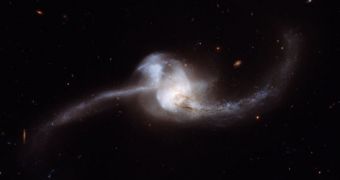The Hubble Space Telescope has recently imaged a very weird-looking galaxy, which appears to be a two-armed spiral one at first glance. However, upon closer inspection, astronomers discovered that the formation was, in fact, the result of a massive, high-speed collision, taking place approximately 250 million light-years away from the Earth. The experts also noticed blue-colored areas of intense stellar formation in the resulting arms, hinting at huge amounts of stellar dust and gas being generated, and then collapsing onto themselves to form new stars.
The resulting galaxy, dubbed NGC 2623, or Arp 243, is located in the constellation Cancer, and it is extremely active in infrared wavelengths. As such, it has been included in the luminous infrared galaxy (LIRG) group, scientists explain. It has been extensively studied as the part of the Great Observatories All-sky LIRG Survey (GOALS), which combines data from a large number of ground- and space-based telescopes, including the Hubble. When dealing with cosmic objects such as active galactic nuclei and nuclear star formation, data from X-ray and infrared observatories are also included.
The reason why so many stellar nurseries appear in the two trailing arms is because, as the galaxies approach each other, massive amounts of gas are pulled from one to the other at incredibly high speeds. In the end, this will result in the two formations combining into one, but, until then, the process will carry on at its current rate. In the case of NGC 2623, the merger is already in one of its final stages, as the two galactic cores have already fused together. The only areas that have yet to come together are the arms, but they may very well continue to remain separate, forming a two-armed spiral galaxy.
The galaxy was also proven to have an active galactic nucleus. Such a phenomenon implies that the collision has sprung one of the supermassive black holes at the center of the two structures into action. As it begins to spin and engulf matter, the black hole forms an accretion disk around its event horizon. The motion causes the disk to be heated up, and emit radiation over a wide electromagnetic spectrum. These signals can be picked up by radio, X-ray and gamma-ray telescopes, if they are sensitive enough, the astronomers conclude.

 14 DAY TRIAL //
14 DAY TRIAL //